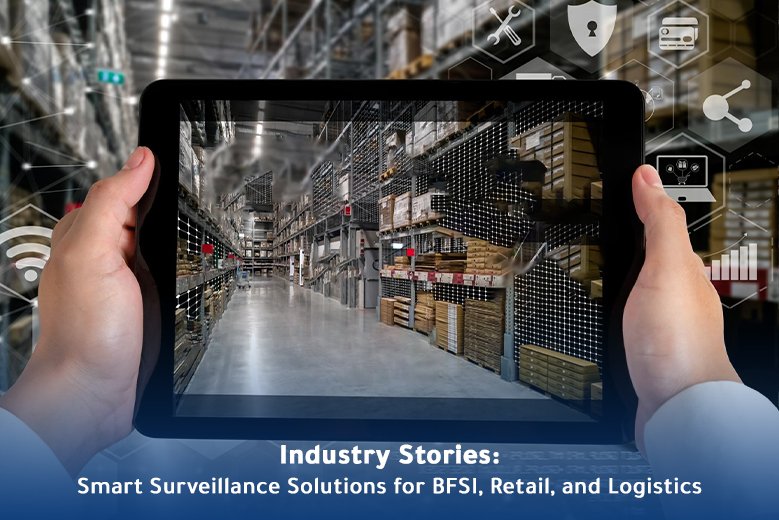Smart surveillance has moved from “record and hope” to “sense, decide, act”. Banks want resilient operations and cleaner audits. Retailers need to cut shrink without ruining the shopping vibe. Logistics teams crave live visibility, not day-old footage that tells them what went wrong after the damage is done. Different worlds, same goal: reduce risk, save time, and help people do better work.
BFSI: Uptime, Compliance, and Calm Operations
A national bank set a blunt target: cut incident response from hours to minutes across branches and ATMs. Step one was a unified command view that blended camera feeds with alarms and access control. Step two was device health: camera online status, storage headroom, firmware age, and basic cyber posture. If a branch went dark, the platform opened a ticket automatically, pinged the local team, then escalated if nothing changed.
Crucially, video analytics were paired with vault sensors and duress alerts; false positives dropped, and the real events rose to the top. Compliance got easier too: cleaner audit trails, predictable retention, and consistent configurations. The clincher? The bank brought in infrastructure monitoring services for BFSI so operations could spot failing drives, stale passwords, or risky ports before auditors did. Less drama on payday Friday. Fewer out-of-hours call-outs. A calmer room.
Retail: Theft Down, Experience Up
A fashion chain was leaking stock at self-checkout and in fitting rooms. The fix started with human basics: clearer floor layouts, better sightlines, and honest signage. Then came targeted analytics, queue length alerts, occupancy thresholds, and object-left detection by exits. Store teams no longer stared at a wall of thumbnails; they watched a tidy dashboard. If a high-risk pattern appeared, supervisors got a nudge with suggested actions: observe, engage, or call security.
Just as important, privacy rules were baked in from the start. Footage minimised. Retention short. Access is tightly controlled. The end result combined security and service: friendlier shops, sharper controls, and quieter loss-prevention meetings. In short, smarter retail shop security that customers barely notice, until they realize how smooth the experience feels.
Logistics: Know Now, Not Later
A regional distribution network wanted to spot bottlenecks before trucks snaked onto the road. Cameras at gates, docks, and yard lanes fed a lightweight model that tagged arrivals and departures, overlaying ETAs from the transport system. When dwell times crept above target, the yard manager got a prompt to add a crew or move a trailer. During storms, perishables were prioritised automatically.
For damage claims, teams pulled the exact clip by consignment ID in seconds, not hours. This is the everyday value of logistics real-time video surveillance: fewer blind spots, faster turns, saner shifts. And yes, drivers noticed too, less waiting, fewer surprises, more predictable handovers.
What AI Adds, and What It Shouldn’t Replace
Good deployments don’t chase shiny features. They pick specific outcomes and work backwards. Use models for pattern spotting, counting, and triage. Keep people for judgment, context, and care.
That’s where the benefits of AI smart surveillance really show up: faster triage, fewer missed events, cleaner evidence, and calmer teams who trust the system. One caveat: measure, don’t assume. If alerts don’t change behaviour, fix the workflow, not just the model.
Security, Privacy, and IT Hygiene
Strong programmes start with basics: unique credentials, encrypted links, signed firmware, and regular health checks. Decide what stays on-prem and what lives in the cloud; latency, bandwidth, and data-residency rules differ by sector and state.
Document retention in plain language and stick to it. Train frontline teams on signage, subject-access requests, and incident playbooks, because compliance lives or dies on the shop floor and in the branch, not only in a policy PDF.
From Pilot to Roll-Out: A Pattern That Works
- Pick one painful workflow, evidence retrieval, queue management, cash-room access, and define success in numbers.
- Pilot in two contrasted sites: one easy, one hard.
- Collect weekly metrics, share wins and misses, and refine.
- Standardise the stack, cameras, NVRs, analytics, and dashboards, then scale with confidence.
- Keep a “maybe later” backlog so experiments don’t derail the core.
What Success Looks Like
For banks, it’s fewer outages, tighter audits, and a command room that stays calm when the lines peak. For retailers, it’s lower shrink, brisk checkouts, and staff who feel supported, not watched. For logistics, it’s trucks turned on time, tidy yards, and fewer disputes with customers. None of this is magic. It has clear goals, decent kit, and the discipline to keep tuning.
Final Thoughts
Start small. Measure honestly. Treat people with respect. The technology is ready; the craft is in how you deploy it. Smart surveillance should make places feel safer and work smoothly. When it does, everyone, from branch managers to drivers to shoppers, feels the difference.
At Intellve, we build secure, STQC-ready video and command platforms that unify cameras, sensors, and alarms into one calm, real-time view. From BFSI to retail and logistics, we help you cut response times, simplify audits, and scale confidently. Book a demo with us today.



